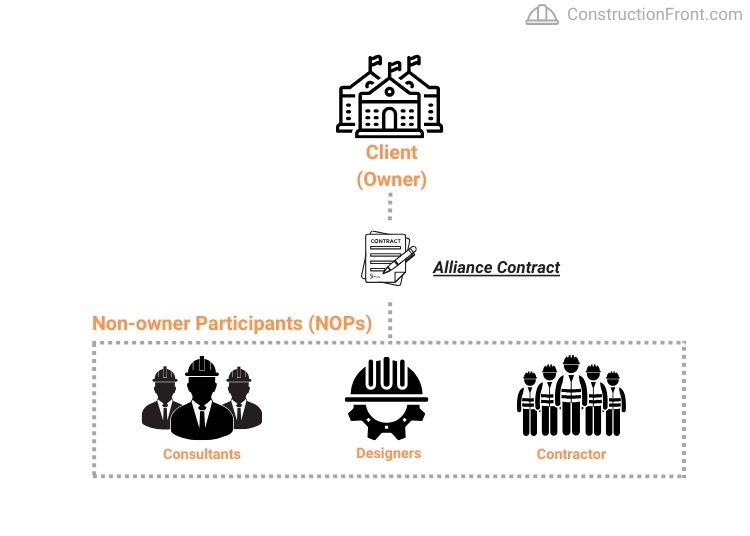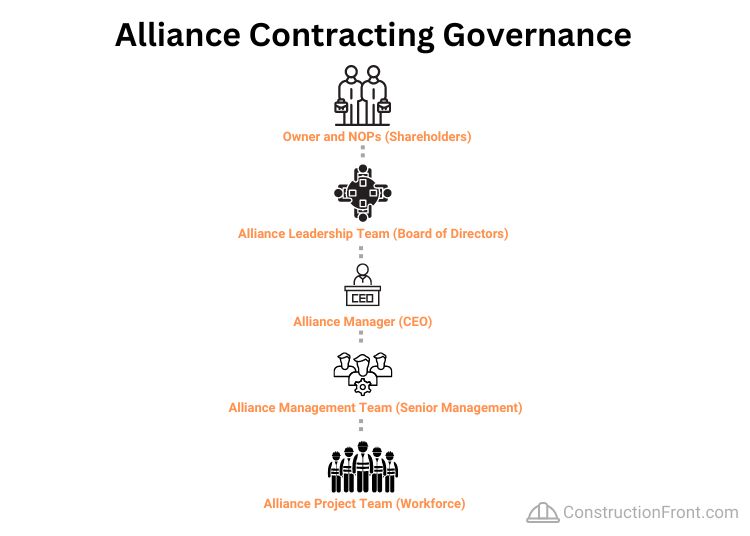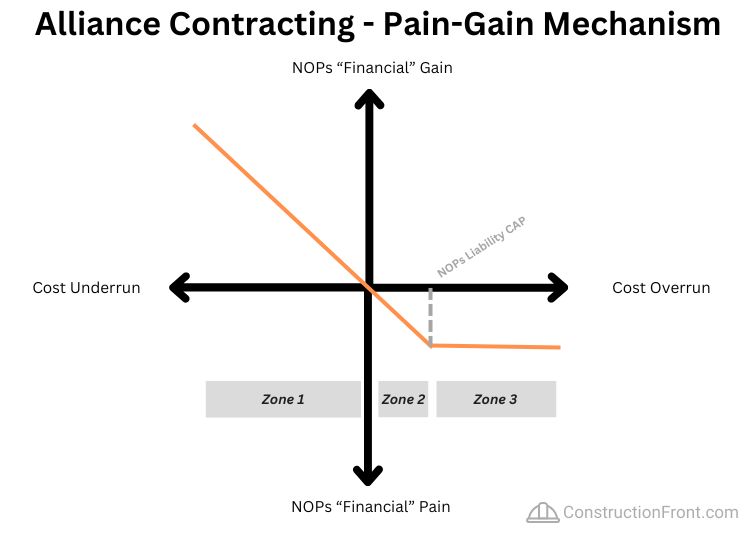Construction contracts are known for their adversarial nature and numerous disputes. Over the last decades, alliance contracts have gained prominence in the construction industry as an alternative to delivering projects more collaboratively. But what is it?
Alliance contracting is a project delivery method where all parties, including owners, contractors, and sometimes even designers and consultants, form an alliance to work collaboratively. This approach prioritizes shared goals, open communication, and risk-sharing among all parties. The alliance agreement is drafted and structured to avoid “win-lose” scenarios, foster “win-win” approaches, and typically includes pain and gain-sharing mechanisms.
In this article, we will explore the concept of alliance contracts further, detailing what they are, how they work, their advantages and disadvantages, and examples.
What is Alliance Contracting?
Alliance contracting is a commercial framework typically for delivering significant capital projects in which key parties come together to form a unified team focused on achieving common project goals.
Typically, these parties are divided into two groups:
- Owner – The entity procuring the project and which will hold the asset in the long term
- Non-Owner Participants (NOP) – Other parties involved in project delivery only (Contractors, Designers, Consultants, etc.)

The fundamental concept behind alliance contracting is to harmonize the interests of all stakeholders and foster transparency, trust, and collective accountability throughout the project’s entire duration.
Operating within an integrated and unique team, every member must act in good faith and with integrity to make decisions on a “best-for-project” basis.
According to the Department of Infrastructure and Regional Development of Australia, an alliance contract has the following key features:
- A multiparty agreement, executed between the Owner and NOPs
- Risk-sharing mechanisms embedded in the contract
- Commitment to “no disputes” (very limited variation claims and extension of time claims)
- “No fault ; no blame” culture;
- Good faith
- Best-for-project decision-making processes
- Transparency (project undertaken on an “open-book” basis)
- Joint management structure
How does an Alliance Contract Work?
This section will explore two characteristics of alliance agreements that vastly contribute to increase collaboration between the parties: governance structure and risk-sharing mechanisms.
Alliance Contract - Governance Structure
One of the critical aspects of alliance contracting is its contract governance structure. Typically, these agreements have a joint management structure akin to the governance structure of a private company.
Albeit names, definitions, number of layers, and specific details might differ on each agreement and jurisdiction, alliance agreements usually have the following governance layers:

Governance Layer | Description / Role | Private Company Structure |
Owner and NOPs |
| Shareholders |
Alliance Leadership Team (ALT) |
| Board of Directors |
Alliance Manager (AM) |
| CEO |
Alliance Management Team (AMT) |
| Senior Management |
Alliance Project Team (Or Delivery Team) |
| Workforce |
Alliance Contract - Risk Sharing Mechanisms
Risk-sharing is probably the main feature of alliance contracts. The contract is generally executed with a Target Outrun Cost (TOC), a cost benchmark or ceiling used to govern the pain-gain mechanism.
In contrast to traditional procurement and contracting methods, most risks are shared between alliance members, such as design errors, artefact and valuable findings, latent conditions, unknown utilities, and many others.
In summary, the pain-gain mechanism is designed so that if the alliance can deliver the project below the TOC, all alliance members share the savings within a pre-agreed ratio (typically 50% for the Owner and 50% for NOPs).
On the other hand, if the alliance finalises the project above the TOC, all the parties also share the pain within a pre-agreed ratio. The detail here is that agreements usually set a maximum loss amount (“loss cap”) by which NOPs will be liable.
The graph and table below summarise a common the pain-gain mechanism. To facilitate understanding, we have split the chart into three zones highlighted in the grey bars.

Zones | Description | Pain-Gain Share |
Zone 1 | Project is completed within (below) the Target Outrun Cost (TOC) and project savings are shared between the Owner and the NOPs. | Status: Gain Typical sharing: Owner – 50% NOPs – 50% |
Zone 2 | The project is completed above the pre-established TOC (overspending), and project losses are split between Owner and NOPs | Status: Pain Typical sharing: Owner – 50% NOPs – 50% |
Zone 3 | The project is completed above far above the pre-established TOC and above the NOP liability CAP. Project losses are split between Owner and NOPs until a pre-established liability CAP. Losses after this CAP are 100% absorbed by the Owner. | Status: Pain Typical sharing: Owner – 50% up to NOP liability CAP; 100% after it NOPs – 50% up to NOP liability CAP ; 0% after it |
Important Notes:
- Sometimes, alliance agreements can exclude some specific risks from the collaborative risk-sharing approach, such as soil contamination.
- NOPs financial exposure is usually capped at NOPs total profitability margin.
Alliance Contracting - Advantages
The table below details some of the main advantages of this contracting approach.
Advantages of Alliance Contracting | Description |
Shared Risk and Reward | Parties collaborate with shared accountability and mutual interests, leading to collective success. |
Enhanced Collaboration | Encourages open communication and teamwork among stakeholders, fostering a cooperative environment. |
Innovative Problem-Solving | Promotes creative solutions to challenges and value-engineering initiatives, as parties strive to find efficient, cost-effective resolutions. |
Improved Risk Management | Risks are shared collectively, reducing individual financial exposure and enhancing risk management. |
Efficient Decision-Making | Streamlines decision-making processes, enabling collaborative evaluation and selection of the best course of action. |
Cost Savings | Optimizes project costs by reducing disputes, minimizing delays, and ensuring efficient resource allocation. |
Early Issue Identification | Encourages the early detection of issues, enabling proactive problem-solving and risk mitigation. |
Transparency | Enhances transparency in project operations, facilitating tracking of progress, costs, and performance against benchmarks. |
Flexibility | Allows for adaptability in project design and execution to accommodate changing circumstances or new information. |
Alliance Contracting - Drawbacks and Challenges
As with every procurement method, there are numerous challenges associated with alliance contracts, such as:
Challenges and Drawbacks of Alliance Contracting | Description |
Complexity in Governance | Alliance contracts require intricate governance structures and decision-making processes, which can be challenging to establish and manage. |
Potential for Disputes | Collaborative environments may still experience disputes, requiring effective conflict resolution mechanisms. |
Resource Intensive | Setting up and maintaining alliance contracts demands significant resources in terms of time, effort, and personnel. |
High Upfront Costs | The initial setup costs, including legal and administrative expenses, can be relatively high for alliance contracting. |
Dependency on Trust | Success in alliance contracts heavily relies on trust among parties; distrust or conflicts can undermine collaboration and lead to adversarial behavior. |
Balancing Individual and Shared Goals | Balancing individual interests with the collective good can be complex and may require ongoing negotiation. |
Longer Setup Period | Establishing an alliance contract and aligning all parties may take more time compared to traditional contract methods. |
Limited Use in Smaller Projects | Alliance contracting may not be practical for small-scale projects due to its complex nature and resource requirements. |
Potential for Uneven Risk Sharing | Despite shared risks, disparities in contributions or responsibilities among parties can lead to uneven risk-sharing. |
Dependency on Collaboration Skills | Effective collaboration is crucial; if parties lack the necessary skills or willingness to collaborate, it can hinder success. |
When Alliance Contracts should be used?
Alliance contracts are particularly suited for complex projects with high risks, and successful outcomes require extensive collaboration.
This contracting approach is commonly used when:
- Risks cannot be accurately defined and measured during the project feasibility phase;
- There is no market appetite to transfer these risks (i.e. Contractors will hardly assume soil contamination risks, given its significant risk exposure) and/or the cost of risk transfer is prohibitive.
- Owners wish to kick off the project as early as possible and might even engage the NOPs during the development phase to leverage their expertise and de-risk the project in the early days (another early contractor involvement alternative is the managing contractor approach); and
- Owners acknowledge that a collective risk management approach will deliver better outcomes.
Alliance Contract - Recent Project Examples
- Central Station Upgrade – Sydney Metro (Sydney, Australia) – Link to the General Contract Conditions here. (Note: The author has worked on this project).
- Laing O’Rourke-Kier-Wates JV to deliver prison facilities in the UK via an Alliance Contract – Ministry of Justice (MoJ) (UK)
FAQ and Related Questions
What is the difference between partnering and alliancing?
Partnering and alliancing both promote collaboration but differ in their contractual structures. Partnering typically involves a less formal agreement aimed at improving relationships between parties.
Alliance contracting, on the other hand, is a formal arrangement with shared risks and rewards, often resulting in a legally binding contract.
What is a Target Outrun Cost (TOC)?
A Target Outrun Cost (TOC) in alliance contracting is the predetermined cost ceiling that a construction project should not exceed. Parties work collectively to stay within the TOC, incentivizing collaboration and cost control.
Any savings achieved under the TOC are typically shared among alliance members, fostering cooperation and responsible budgeting throughout the project’s duration.
On the other hand, losses are usually shared between Owners and NOPs up to the pre-established threshold.
Alliance Contract vs Traditional Contracting - What is main the difference?
Some of the key differences between Alliance Contracting and Traditional Procurement Methods are detailed in the table below.
Aspect | Alliance Contracting | Traditional Contracting |
Collaboration | Emphasizes strong collaboration | Typically involves minimal collaboration |
Risk Sharing | Shares risks and rewards collectively | Risk distribution is often uneven |
Project Outcomes | Focuses on collective project success | Primarily concerned with individual performance |
Decision-Making | Encourages joint decision-making | Decisions are often made individually |
Innovation | Fosters innovation and problem-solving | Innovation may be limited due to competition |
Contract Structure | Less emphasis on fixed contracts | Relies on fixed contracts and bidding (Lump sum contracts) |
Relationships | Promotes a cooperative environment | May lead to adversarial relationships |
.
Is an alliance a Legal Entity?
Generally speaking, an alliance contract does not establish a new entity. However, parties work together and develop governance structures similar to a company to manage the contract (refer to the alliance contract – governance structure part above).
How to Procure Alliance Contracts?
The procurement of alliance contracts will vary on clients, jurisdictions and legislation prevalent around the construction project. As a rule of thumb, it is suggested that a Phased procurement approach is used, and owner shortlist NOPs that”
- Have a successful track record of collaborative contracting.
- Have proven ability and technical skills to deliver the project
- Other KPIs are incorporated into the agreement, such as relationship and collaboration between owner and NOPs, risk management approach, etc.
Conclusion
Alliance contracts are an interesting alternative to delivering construction projects using a collaborative approach. Owners have been using this contracting model given their many advantages, such as risk-sharing, transparency, a “win-win” approach, and enhanced collaboration.
The limited financial exposure created by the risk-sharing mechanisms is also beneficial for contractors and NOPs, who feel comfortable engaging in a contract where they know their maximum financial exposure.
However, they are typically burdensome contracts, requiring experienced teams and a significant management workload for contractors and owners, limiting their use for small-scale and “vanilla” agreements, where risks are easily identifiable and transferable.
Need Help?
Do not hesitate to contact us for specialised advice in construction contracts (click here)













